Key takeaways:
- Selective mutism is not a choice but a response to overwhelming anxiety, making communication difficult for affected children.
- Common misconceptions include the belief that children will outgrow selective mutism or lack social skills; in reality, they often want to communicate but struggle due to anxiety.
- Support strategies should focus on creating a trusting environment, utilizing non-verbal communication, and involving family to foster effective communication.
- Raising awareness is essential to understanding selective mutism and recognizing the internal struggles individuals face, promoting empathy and inclusive environments.

Understanding Selective Mutism
Selective mutism is more than just a reluctance to speak; it can feel like an invisible wall separating a child from their world. I remember a friend’s daughter, so bubbly at home, yet utterly silent in school. It made me question—what could be going through her mind in those moments of quiet?
Often, those with selective mutism are not being defiant; they’re navigating an overwhelming fear of social interactions. Imagine standing in a room filled with people, your voice trapped inside, while your heart races. This isn’t just shyness; it’s a paralyzing fear that can be deeply misunderstood by those around them.
When I reflect on how communication works for someone with selective mutism, I realize the struggle goes beyond words. It’s about feeling seen and understood without the need for speech. How valuable would it be if we could recognize non-verbal cues and the emotions behind them? This kind of empathy can make a significant difference in bridging the gap for someone affected by selective mutism.
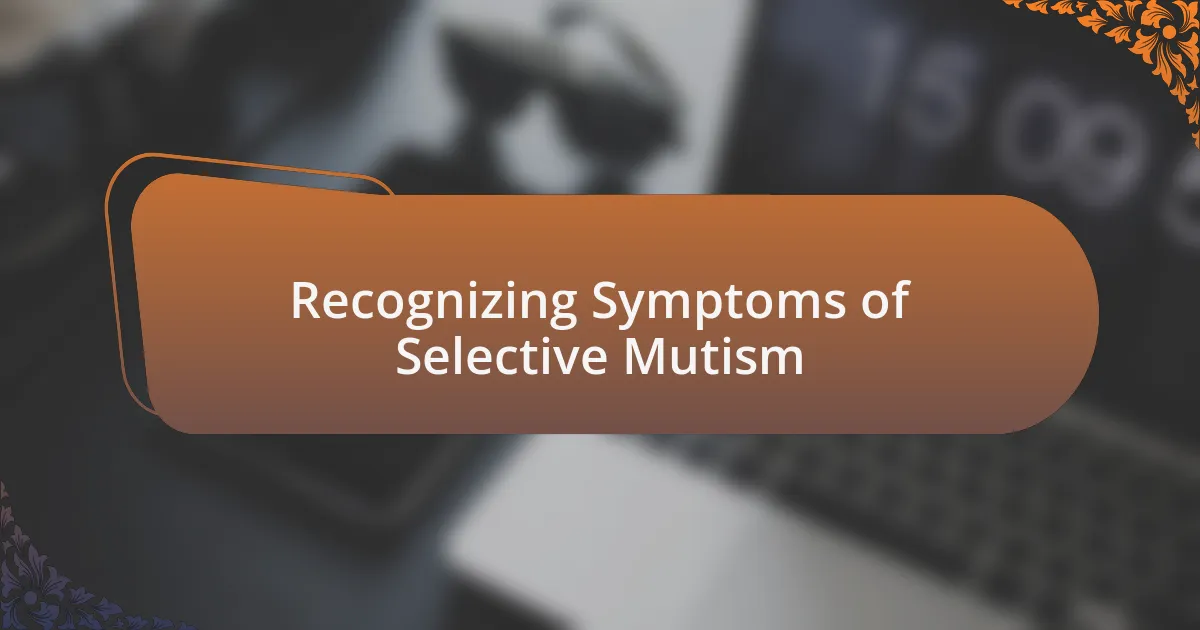
Recognizing Symptoms of Selective Mutism
Recognizing the symptoms of selective mutism can be challenging, especially since children may be expressive in familiar settings but appear completely withdrawn in social situations. I remember visiting a classroom where a usually animated student froze at the sight of peers. Watching her struggle to even nod in response to a simple question left a mark on me. Why is it so easy for some to dismiss these signs as mere shyness?
Another key symptom is the inconsistency of speech. Some kids might speak fluently at home but clam up in public. I recall hearing about a boy who could recite stories to his family but was mute during school presentations. This disparity illustrates how the environment can trigger intense anxiety, leading to silence when it matters most. It makes me wonder how many teachers overlook these indicators, thinking the child is simply introverted rather than battling anxiety.
Physical signs can also accompany selective mutism. Children may exhibit avoidance behaviors, such as hiding behind a parent or avoiding eye contact. I once observed a little girl cling tightly to her mother while avoiding the gaze of her classmates. It struck me then that these actions are cries for help, revealing the internal struggle that often goes unnoticed by those around them. Can we learn to see these signs more clearly and offer the understanding they need?
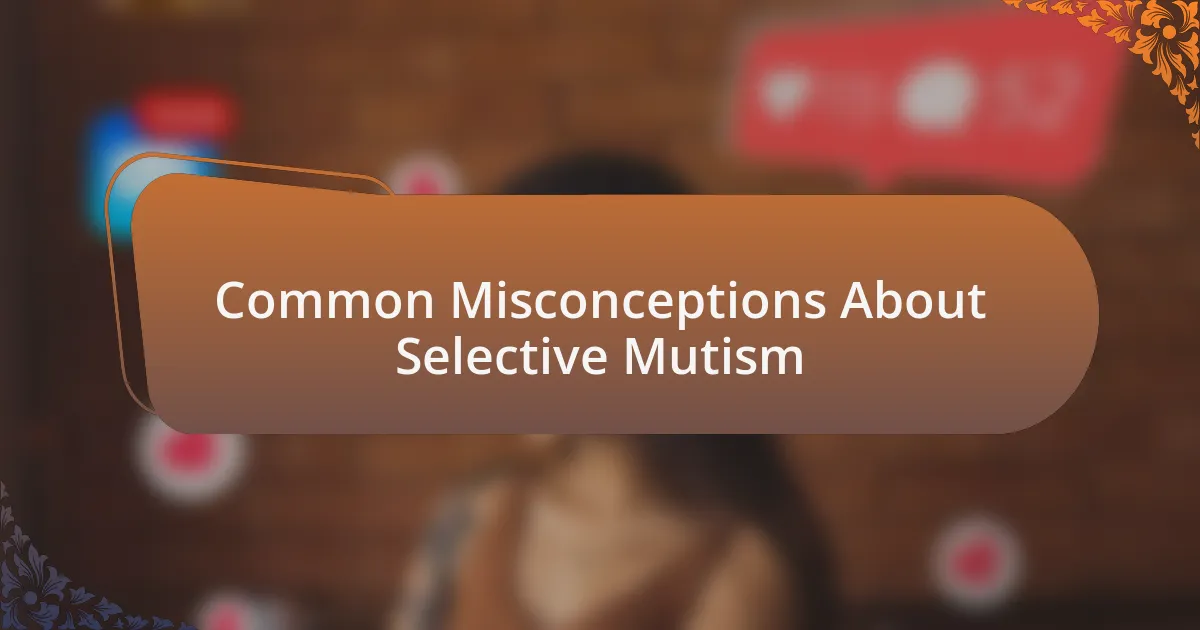
Common Misconceptions About Selective Mutism
It’s a common misconception that children with selective mutism simply choose not to speak. I remember a parent expressing frustration, believing their child was just being stubborn. This highlights a crucial misunderstanding; children experiencing selective mutism desperately want to communicate but feel overwhelmed by anxiety. Realizing this distinction can dramatically change how we approach these children.
Another frequent misconception is that selective mutism is merely a phase that children will outgrow. I once spoke to a teacher who dismissed a quieter student, assuming they would “come out of their shell” in time. This overlooks the reality: selective mutism often requires targeted support and understanding. Without it, we risk leaving children feeling trapped in their own silence, which is anything but a fleeting phase.
Many people think that children with selective mutism lack social skills, but this couldn’t be further from the truth. I’ve met children who, although silent, exhibit a remarkable ability to connect with their peers through non-verbal cues, like smiles or gestures. It’s essential to remember that their silence doesn’t equate to an absence of social awareness; rather, it stems from an intense struggle against anxiety. How often do we fail to see the potential within these quiet souls?
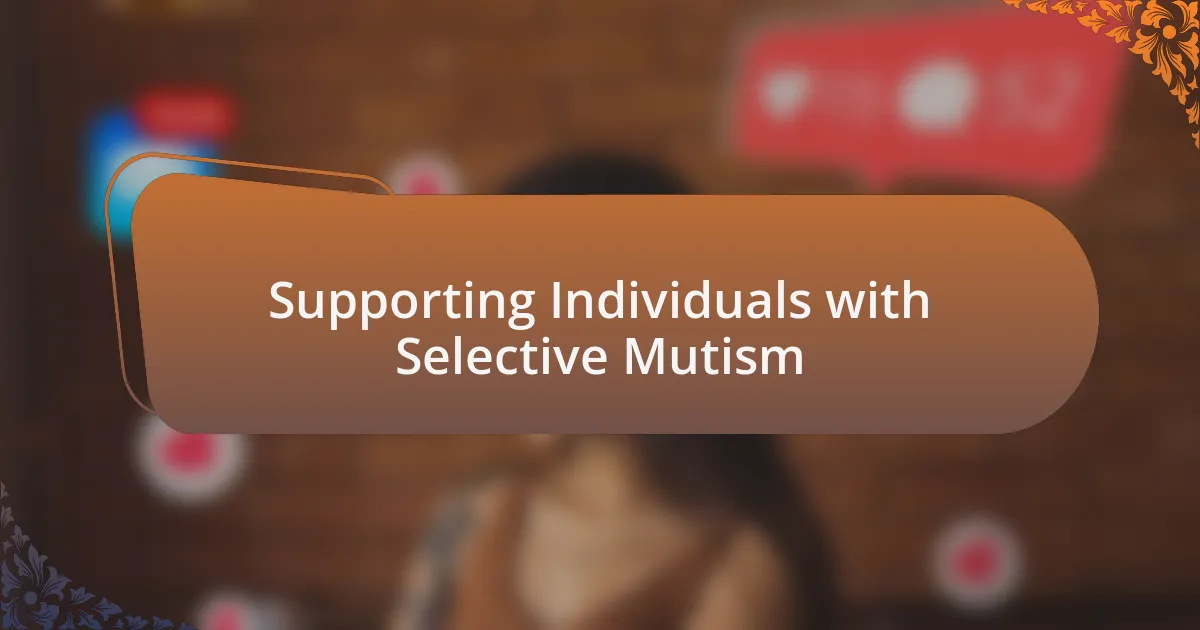
Supporting Individuals with Selective Mutism
Supporting individuals with selective mutism requires patience and understanding. I recall a time when I observed a young girl in a classroom setting. Rather than pressing her to speak, her teacher gently encouraged her to participate in activities that didn’t require verbal communication, like drawing. This small shift allowed the girl to express herself in a way that felt safe, revealing that the right support can empower them to communicate more effectively over time.
Establishing a trusting environment is crucial for anyone dealing with selective mutism. I noticed a school counselor who took the time to get to know each child individually, fostering relationships built on trust and respect. This approach not only calmed their anxiety but also encouraged them to share their thoughts and feelings—often, they just needed that initial nudge from someone who cared. Have you ever felt the weight lift when someone truly listened to you? That’s the kind of connection we should aim for.
Involving family in the support process can be transformative as well. I had a friend whose son experienced selective mutism, and through family workshops, they learned strategies to communicate at home that made all the difference. It was heartwarming to see him start using words not just at school, but with his family too. How could we better engage families to ensure their support extends beyond the classroom? This collaborative effort is essential for creating a nurturing atmosphere where children feel empowered to find their voice.
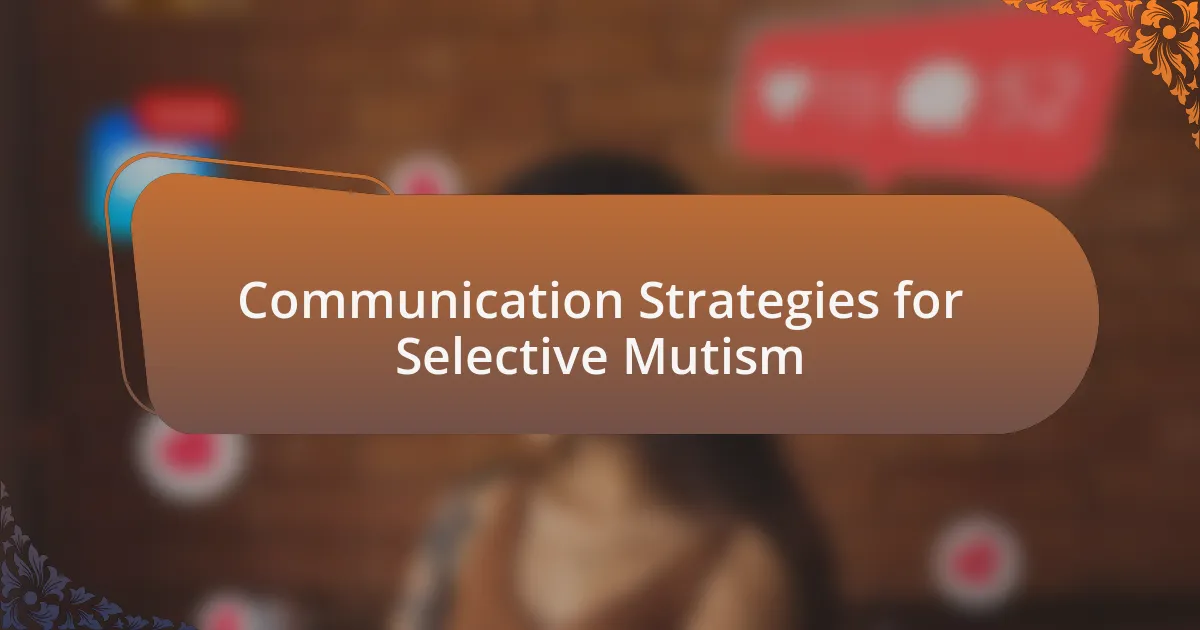
Communication Strategies for Selective Mutism
Fostering communication for individuals with selective mutism often involves using non-verbal cues. I once saw a child express herself beautifully through facial expressions and body language while playing with toys. This made me realize that we shouldn’t underestimate the power of gestures; they can be just as potent as spoken words. Have you ever felt more connected to someone when you shared a moment of laughter or a smile?
Creating low-pressure communication opportunities is another effective strategy. In a group setting, I noticed that introducing activities like role-playing games allowed children to act out scenarios without the pressure of speaking outright. I can’t tell you how many times I saw kids break through their silence when they realized they could express themselves in creative ways without judgment. It’s about finding that unique way for each child to let their voice be heard, wouldn’t you agree?
Lastly, using visual aids can greatly enhance communication. I remember working with a child who thrived when using images to convey her feelings. By incorporating picture cards, she was able to express her needs and emotions without needing to verbalize them. This experience taught me how visuals can bridge the gap where words often fall short. Have you thought about how simple tools like these can truly make a difference in someone’s ability to communicate?
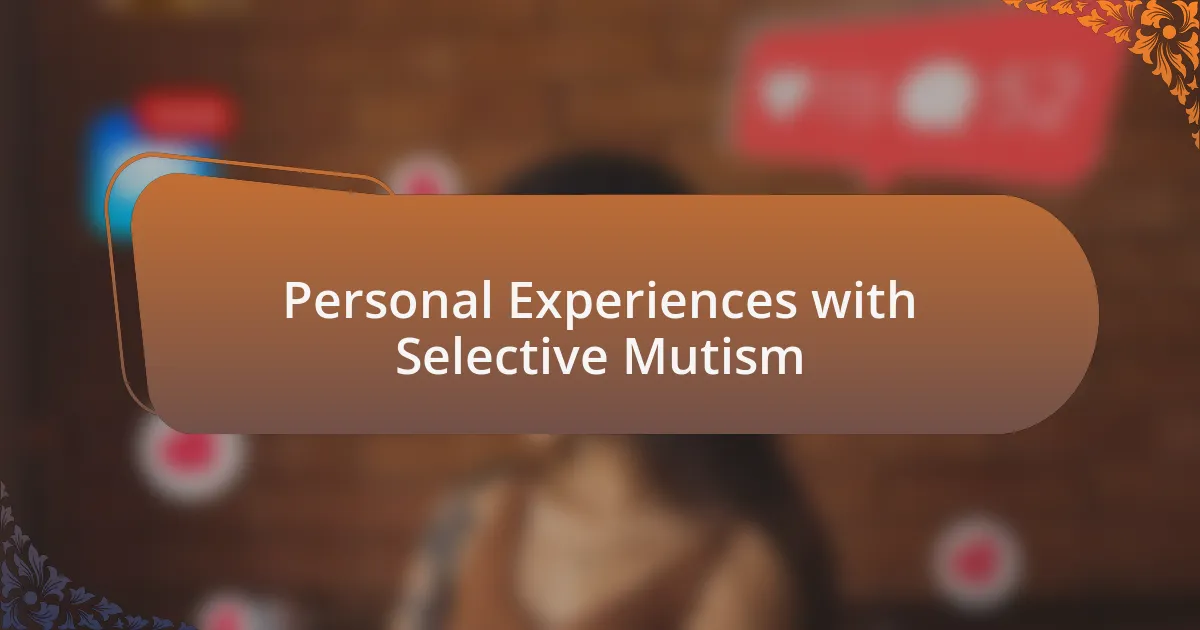
Personal Experiences with Selective Mutism
One moment that stands out to me was when I attended a school event and noticed a child with selective mutism sitting quietly, seemingly lost in her own world. As I observed, she found a safe corner and began doodling. It struck me how creativity can serve as an outlet for those who struggle to find words. Have you ever felt a rush of emotion while expressing yourself through art in ways that words couldn’t capture?
I also recall a specific interaction with a young boy who only spoke in whispers. I remember sitting next to him on a bench during recess, allowing the silence to envelop us. Rather than pushing him to talk, I simply shared what I was feeling at that moment, and to my surprise, he began to open up very slowly, sharing his thoughts in his own time. This taught me the value of patience; it made me wonder—how often do we rush conversations without considering the comfort of the other person?
Reflecting on another experience, I was struck by how impactful a supportive adult can be. I once witnessed a teacher who took the time to encourage a quiet student during class discussions. She gently prompted him with open-ended questions, fostering a supportive environment. The transformation was beautiful to see—he began to share his ideas, albeit hesitantly at first. Isn’t it fascinating how the right encouragement can change someone’s willingness to engage?
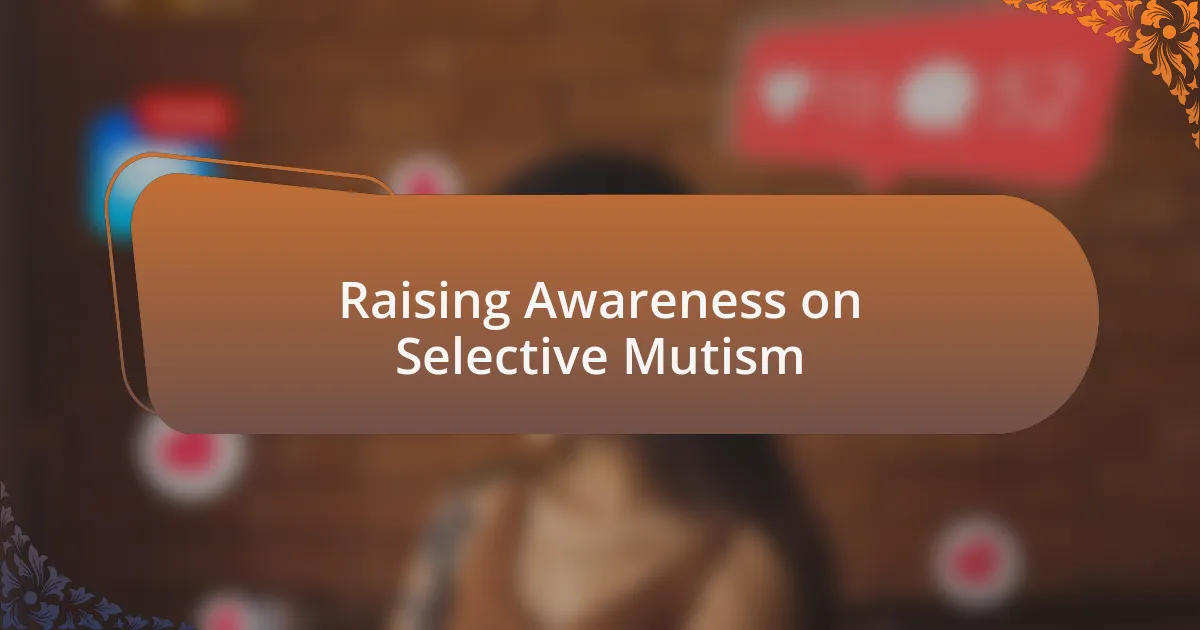
Raising Awareness on Selective Mutism
Raising awareness on selective mutism is not just about understanding the condition; it’s about embracing the unique pathways of communication that individuals with this challenge navigate daily. I vividly remember a poignant moment at a community event where a mother shared how her daughter’s selective mutism wasn’t a refusal to speak but rather a response to overwhelming anxiety in social situations. It made me reflect—how often do we jump to conclusions without appreciating the deeper story behind someone’s silence?
In my experience, educating those around us, from peers to educators, can significantly change the dynamic for individuals dealing with selective mutism. I recall facilitating a workshop for teachers, where we discussed strategies to foster communication with non-verbal students. One teacher shared how simply allowing extra wait time before asking questions transformed her classroom. Isn’t it interesting how small adjustments can create a ripple effect, leading to more inclusive environments?
Awareness also extends to recognizing the internal struggles faced by those with selective mutism. I once spoke with an adult who shared that even in adulthood, social situations could trigger anxiety that rendered him mute. He expressed how awareness initiatives could demystify selective mutism, fostering environments where individuals feel seen and understood. Doesn’t this illustrate the importance of compassion in our interactions?